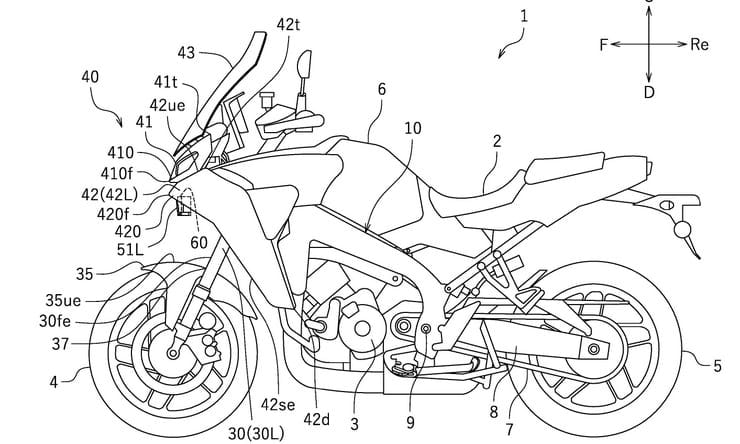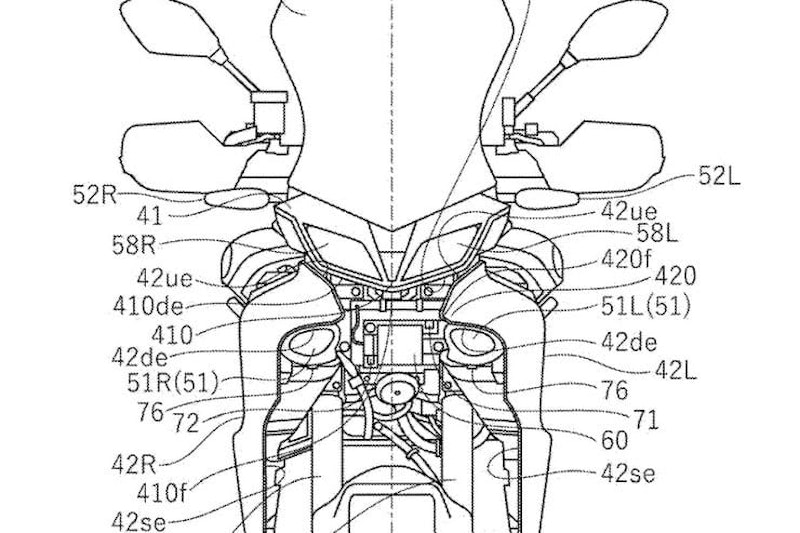Yamaha Tracer 9 radar cruise details leaked
By Ben Purvis
Motorcycle Journalist
27.09.2022
It emerged back in July that Yamaha’s 2023 Tracer 9 GT was in line to get radar-assisted adaptive cruise control in 2023 and now that’s looking more likely than ever with the emergence of patent applications that show precisely that technology fitted to the bike.
While radars are becoming increasingly common on bikes, with Bosch’s purpose-made motorcycle system dominating the market and already used by Kawasaki, Ducati, KTM and BMW, the Tracer 9 looks set to be cheapest way to get hold of radar cruise and safety kit, marking the technology’s entry into a completely new part of the market.
The radar is the square unit marked ‘60’ in the centre of this picture, between the low-mounted main headlights
At the moment, getting hold of a bike with radar cruise control means parting with well over £15,000 to get your hands on a KTM 1290 Super Adventure S, or even more to get a BMW R1250RT, Kawasaki Ninja H2 SX or Ducati Multistrada V4 fitted with the system. But just as other tech like TFT instruments or Bluetooth connectivity has rapidly filtered down to much more mundane machines, radars are sure to become more widely available every year, spreading to more mainstream models like the Tracer 9.
Yamaha’s new patent illustrates how the radar is bolted to a bracket between the Tracer’s headlights, which are already helpfully mounted low down underneath the nose, with a dark gap between them that’s perfect for hiding the radar sensor.
Fitted to a bracket between the lights, the radar unit’s aim can be adjusted via two screws
Yamaha appears to be using the same Bosch radar unit employed by Ducati, BMW, KTM and Kawasaki, and as it’s a proven, low-cost, off-the-shelf system that makes a lot of sense. Bosch has a stranglehold over the motorcycle market when it comes to ABS, IMUs and traction control systems, so most manufacturers already have a strong relationship with the German company as a supplier. By offering a ready-to-go radar system that already plays nicely with a bike’s ABS and ride-by-wire throttle systems, the Bosch system ensures is likely to be favoured by most bike brands that already use Bosch electronics elsewhere. The fact that Bosch has already been making radars for cars for many years – and indeed the sensor used on bikes is all but identical to an existing car design – helps cut the cost.
The patent itself revolves around the mounting system rather than the radar technology, as there’s a challenge to positioning the radar where it can get an unobstructed view of the road ahead while also avoiding vibrations or flex in the mounting bracket. Yamaha’s solution is a beam between the headlights that forms a platform for the sensor, which is mounted rather like an additional headlight, complete with adjuster screws to alter its aim.
This image shows that on the finished bike, the radar will be hidden behind a smooth plastic cover (80) that the electromagnetic waves can pass straight through
Like other radar setups, the Yamaha unit will give the Tracer 9 adaptive cruise control and probably some sort of alert system or accident mitigation braking system that comes into play if it thinks you’re approaching an obstacle too fast.
Interestingly, Yamaha is only the second company after Kawasaki to opt to put a cover over its radar unit. BMW, Ducati and KTM leave the radars themselves on display, since putting obstacles like bodywork in their path could interfere with the electromagnetic waves emitted by the radar and the echoes of those waves that are received by the sensor to judge the distance to an object ahead. Yamaha’s patent features a radar-invisible plastic panel in front of the sensor, rather like Kawasaki’s latest Ninja H2 SX, which not only hides it from sight for improved aesthetics but also protects the electronics by keeping away the worst of the road dirt, water, insects or stones that might otherwise be thrown at the radar. The smooth plastic covering it should be easier to clean, too, and if it gets scratched or chipped – imperfections that could hinder the radar’s efficiency – it will be cheaper to replace the cover panel than to replace the radar unit itself.
Yamaha has already been seen testing the radar-equipped Tracer 9 GT, and the emergence of this patent document shows that the system has been under development for a substantial amount of time. Firms often delay the publication of patents to coincide with the launch of new models, so it would be no surprise if the radar-equipped Tracer 9 appears alongside other models in Yamaha’s 2023 range in the next few weeks.
The price is unknown at this stage but it seems certain that, with the Tracer 9 starting at £10,700 and the GT version at £12,700, even with a premium for the radar it will be the most affordable new bike with adaptive cruise control.
Share on social media:

